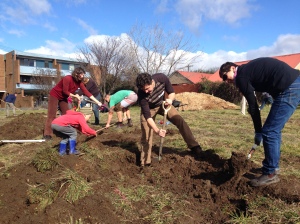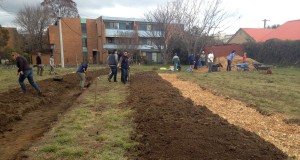
Images and text by Silas Brown
So you might be wondering what is a swale? Well a simple explanation would be ‘A water harvesting ditch, built on the contour of the landscape’. But why do we want to harvest water you might ask. The answer… to grow trees. Yes, swales are always planted with tree systems, and trees love water.
Now, let’s discuss the two main features of a swale that makes them so useful.
Firstly the berm. The berm is the result of all the soil that has been removed from the ditch and placed on the downhill side. This is the perfect place to grow trees (or a Food Forest) and deep rooted plants like strawberries, rhubarb, asparagus, comfrey and dandelions. The deep roots will keep the berm stable and suck up the moisture and nutrients from below.

Secondly the ditch. The basic concept of the ditch is to catch water on contour and allow it to soak into the soil. As water travels down a slope it is intercepted and slowed down to a standstill by the ditch, giving it time to infiltrate the soil. Some of the water is then pulled up into the berm through capillary action, some travels slowly down the hill through the soil and some goes down deep to recharge the groundwater. The ditch can also double as a path and could be filled with mulch such as wood chips.
Other benefits of swales include: eliminating erosion; making healthier landscapes and food systems; texturing the land with beauty and functionality; and decreasing floods by moderating the flow of water.
Swales can be made in many sizes from huge mountain-side swales big enough to drive your car in, all the way down to a small 30cm wide backyard swale. But it’s important to get the scale right for different situations. This involves knowing the amount and type of rainfall and the size of the catchment area. At the Lyneham Commons we have used swales to establish a community food forest. We had advice about our swale dimension and depth from Cam Wilson from Earth Integral. The ditches in our swales are 25cm deep (down to the top of the clay layer), 1.2m wide with a berm 1.5m wide. We deep ripped the soil (with a yeoman’s plow thanks to Matt Kilby from Global Land Repair) before digging our swales which helps water to penetrate deeply while improving soil aeration.
To finish off, here’s a short list to give you some idea of what’s involved in swale building:
- Find the best place for your swale.

Mulching the swales at Lyneham Commons - Mark out the contour using a levelling device.
- Dig the ditch either by hand or with earth moving machinery.
- Make sure the bottom of the ditch is perfectly level.
- Build an overflow for flood events.
- Mulch the swale or plant with a cover crop to protect the soil.
- Plant your trees.